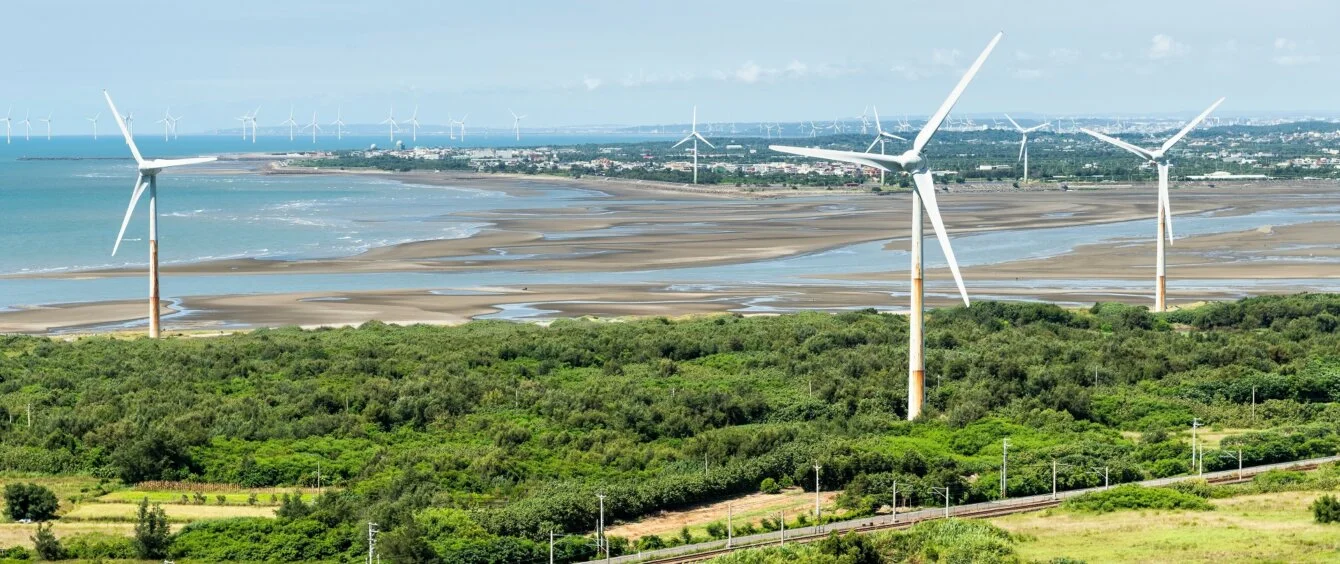Taiwan’s renewable energy sector is growing fast. At the end of 2022, the island nation had 13,813 MW of clean energy capacity, up from 11,240 MW in 2021, an increase of almost 23%, according to International Renewable Energy Agency data.
Renewable energy is a domestic policy priority essential to the achievement of the country’s climate targets, which include reaching net zero carbon by 2050.
It is also a mainstay of efforts to improve the country’s security of energy supply. Taiwan is heavily dependent on energy commodity imports, using primarily coal and Liquified Natural Gas to support a growing renewables sector and declining nuclear capacity.
Offshore wind eases space constraints
Taiwan has a land area of 35,410 km² with a population density of about 674 people per km², the 20th highest in the world. This limits the development of energy sources which occupy land needed for a variety of other uses, including agriculture.
Taiwan is heavily urbanised and has food self-sufficiency of between 35-40%, meaning it imports large quantities of food each year.
The composition of its renewable energy expansion reflects its relative land scarcity and is a prime reason why the government has prioritised offshore wind as perfectly suited to the island’s specific climate and energy challenges.
There is no additional major hydro power potential to exploit. Wind capacity is increasing, but onshore potential is limited. Onshore wind capacity rose from 614 MW in 2013 to 836 MW in 2022.
Offshore wind, in contrast, has jumped from 8 MW in 2017 to 745 MW in 2022 and has plenty of potential for more. At present, the bulk of the country’s renewable energy generation comes from solar power, which reached 9.724 MW last year, up from 410 MW in 2013. Last year saw a record 2 GW of solar installed.
Offshore project pipeline running ahead of infrastructure capacity
Solar power, particularly in urban environments, is certain to keep expanding, but to provide more bulk power and compliment solar’s daytime generation, more offshore wind is a must.
The Taiwan Strait, the body of water lying between Taiwan and mainland China, has an excellent wind resource with potential capacity in excess of 10 GW based on traditional fixed-bottom installations.
However, development has not always been smooth.
According to the Global Wind Energy Council, Covid-19 disruptions delayed the commissioning of projects in 2021. While more than 1 GW of capacity had been expected, only 109 MW came online, followed by a further 508 MW in 2022. At the start of 2022, some 2,010 MW of capacity had been expected to come into operation from five separate projects.
Reasons cited for late delivery include a shortage of vessels and a lack of port assembly areas and infrastructure. Delays in Taiwan can also be compounded by a limited period (April-September) in which weather conditions are best for the installation of offshore wind turbines. Delays and supply chain congestion have led to rising construction costs, making raising finance more difficult.
As a result, there is a disparity between the project pipeline, which is large, and delivery, which to date has underperformed.
Nonetheless, 6.6 GW of new offshore wind capacity is expected to come into operation in the period up to 2026, making Taiwan the second largest offshore wind market in Asia after China, ahead of both Japan and South Korea. This includes more than 5 GW of capacity awarded in 2018, which is expected online before 2025.
Phase 3 auctions further expand project pipeline
The Phase 3 Zonal Development offshore wind auction aims to award a total of 9 GW in three auctions in the period 2022-2024. The results of the first auction were announced in December, awarding 3 GW of capacity across seven projects. Two projects totalling 900 MW have commercial operation dates of 2026 with the remaining capacity to come online in 2027.
Under the Phase 3 Zonal Development auction, localisation requirements were eased, but contracts retain the potential for fines, if the requirements are not met, increasing investors’ financial risk.
The overall ambition is to achieve 5.6 GW of installed capacity by 2025 and install 1.5 GW a year from 2026 with the aim of reaching 13.1 GW by 2030. This would support the goal of 15 GW of new capacity between 2026 and 2035. Beyond that, Taiwan is targeting 45-50 GW of offshore wind capacity by 2050.
Floating wind key to post-2030 expansion
Floating offshore wind is expected to play a major role in meeting the 2050 target. Again, space limitations play an important part in the government’s decision making.
Areas suitable for fixed-bottom installations are running out and have to compete with other maritime activities such as fisheries. Floating wind farms can be deployed in deeper waters further out to sea, expanding the areas free for offshore wind development.
Reflecting floating wind’s pre-commercial status, Taiwan’s Bureau of Energy (BOE) last year proposed a demonstration project framework for floating wind projects. In January, the BOE made amendments to the framework, extending the deadline for grid connection by two years to 2028 and expanding the allowable capacity. It also introduced the possibility of the number of project awards rising from two to three and adjusted the mandatory localisation requirements.
However, expanding into floating offshore wind in conjunction with delivering the country’s ambitious fixed-bottom capacity is likely to present further challenges for local supply chain infrastructure. As the European Chamber of Commerce Taiwan notes, floating wind requires larger ports and wet storage areas, but the options for expansion appear limited, despite strong support from Taiwan’s port authorities for the offshore sector.
Taiwan has set the bar high in terms of ambition. The key challenge now appears to be improving deliverability by investment in the local supply chain and infrastructure, while limiting investor exposure to existing bottlenecks.
